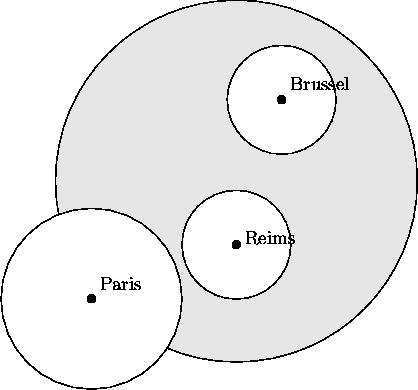



Next: Computational Issues
Up: Modeling Issues
Previous: The Effect Function
OLAF uses grid units for the locational decision variables
 and meter as the physical dimension of the stack height
resp. diameter. It is therefore comparatively simple to add constraints to
the optimization process. The following constraints with respect to the
decision variables
and meter as the physical dimension of the stack height
resp. diameter. It is therefore comparatively simple to add constraints to
the optimization process. The following constraints with respect to the
decision variables  have been added:
have been added:
- Locational constraints:
- The facility has to lie inside a circle
with center at
 W longitude and
W longitude and  N latitude and
radius 180.738km (20 grid units). This translated readily into the
convex quadratic constraint
N latitude and
radius 180.738km (20 grid units). This translated readily into the
convex quadratic constraint

- For hypothetical political reasons, the facility is not allowed to lie
within a circle of radius 100km around Paris and within circles of
radius 60km around Brussels and Reims. With a grid spacing of 9.0869km,
these constraints can be expressed as concave quadratic constraints:

for Brussels,

for Paris, and

for Reims (cmp. Figure 6.9).

Figure 6.9:
The feasible locational region (white area).
- Engineering constraints:
- The stack height has to be between 20m and 90m, i. e.\

- The stack diameter at the top has to be between 2 m and 7m, i. e.\

Note that these simple box constraints for the physical characteristics of
the stack are rather unrealistic. More realistic constraints have to include
a nonlinear coupling between h and w.




Next: Computational Issues
Up: Modeling Issues
Previous: The Effect Function
Joerg Fliege
Wed Dec 22 12:25:31 CET 1999
![]() and meter as the physical dimension of the stack height
resp. diameter. It is therefore comparatively simple to add constraints to
the optimization process. The following constraints with respect to the
decision variables
and meter as the physical dimension of the stack height
resp. diameter. It is therefore comparatively simple to add constraints to
the optimization process. The following constraints with respect to the
decision variables ![]() have been added:
have been added: